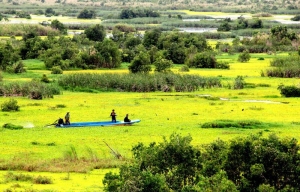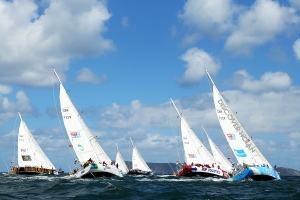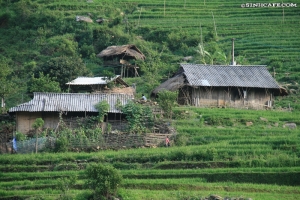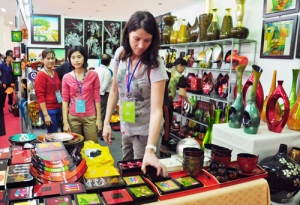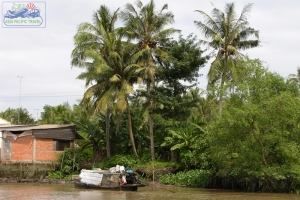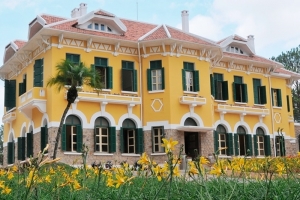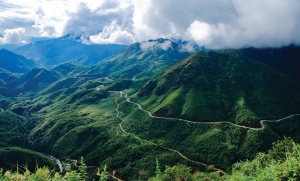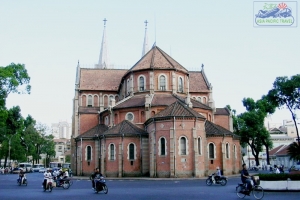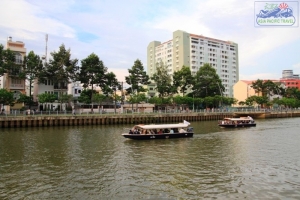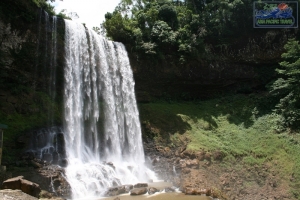In keeping with the ancient Vietnamese adage - Best is to live near a market, next best is a life near a river - Vu Thi Hai, a food seller in Ha Noi, recently went about an exploring tour along the Hong (Red) River that turned out to be not just fascinatingly enchanting but also left her with many warm memories.
Hai said her tour had left her with many soothing memories that she will treasure for the rest of her life.
"We visited some famous places along the river, such as Dai Lo Goddess Temple, Dam and Chu Dong Tu temples, and ended the tour at Bat Trang pottery village.
"As we departed very early in the morning, a dim layer of fog floating above the river induced in us a strange feeling. We felt as if we would simply melt into the lovely river scene, even as we longingly watched the beautiful landscape along the two river banks," she said.
The idea of travelling on the river is catching up fast. In order to exploit the tourism potential along the Red River, travel companies in Ha Noi recently introduced a new tour with the theme "Red River - the Bridges."
Since Vietnamese historically believed that the idea of living near a river is second only to living next to a market, a number of villages and ancient relics featuring Vietnamese traditional culture came up along the river over centuries. Among these were the Bat Trang pottery village, the Dong Ho painting village and the Duong Lam ancient village.
Cultural relics typical of the Red River Delta include Phat Tich Pagoda, But Thap Pagoda, Kinh Duong Vuong Mausoleum, and Temples for Goddess (Mau).
These have the potential to develop eco-tourism, handicraft village tourism and spiritual tourism along the Red River.
But to turn the Red River into a popular tourist destination, investment is needed.
Nguyen Thai Dung, deputy director of Thang Long GTC, a travel company that has been conducting tours along the River for 20 years now, said as of now, tours along the Red River had not been developed as a specific tourism product because of many difficulties.
"The first problem is the facilities. The infrastructure is still not good enough and fails to meet the requirements of travellers. In its current state, Chuong Duong Do is just a temporary pier. So, during shallow water season, we have to move the pier to a recent pagoda. If the water is too shallow, the ships cannot dock, and we must stop the ships in the middle of the river and then shift the passengers to the shore by boat."
Nguyen Thu Huong, an official from the Tourism Department under the National Administration of Tourism, said while in many countries, river tourism had been highly developed, it remained tied to the urban areas along the banks of the river, which are thriving and eventful.
"Although the Red River has beautiful scenery, both its banks simply are a long line of reed, banana and maize gardens. Travelling on the river at night, tourists can only see the distant lights of the buildings on both banks.
"Another problem is, people exploit sand in many places along the river bank, leaving sore spots that are jarring to the tourists' eyes and make for a poor picture for prospective tourists," she said.
Product diversification
Almost five years ago, while preparing for the celebration of 1,000 years of Ha Noi, the city Department of Culture, Sports, Tourism organised a tour linking the Red River with Hung Yen Province along the route: Dai Lo Temple - Dam Temple - Chu Dong Tu Temple - Bat Trang pottery village.
So far, among the tours on the River, this route remains the traditional tour, exploiting tourists' craze for viewing the heritage sites and gaining an experience of the handicraft village.
This tour is mostly for domestic tourists and is organised during the festival season after Tet (Lunar New Year) and autumn.
Hoang Thi Kim Van, an official of the Sen Rung Tourism Company, said, "As for the many international visitors who arrived in Ha Noi for the second time, they want to experience travelling along the Red River to study the villages that showcase Vietnamese culture.
"However, infrastructure of harbours is still poor. In fact, the tours along the Red River which combine bicycle tourism to experience the villages en route are quite popular with the international travellers, but these clients require professional services.
"To attract tourists to the Red River, travel agencies must diversify the tourism products," she said.
To meet the requirements of tourists, the Thang Long GTC recently collaborated with localities along the river to organise a half-day tour such as "Red River - the Bridges" for visitors to experience the history of its bridges.
The bridges can be viewed from the river when the ship passes through Chuong Duong, Long Bien, Nhat Tan and Thang Long bridges.
They also organise the tour "Red River - the Journey of Love Songs", to enable visitors to enjoy the love songs associated with the Red River and the unique art forms typical of the northern Delta and Red River civilization, such as Bac Ninh Province's quan ho (love duet) folk songs, chau van (ritual singing), ca tru (ceremonial songs), cheo (traditional operetta).
On this journey, visitors not only can listen to the history of the bridges, but also gently leave floating candles along the river to send their wishes.
Besides, Thang Long GTC is introducing other tours along the Red River as "Back to Hoa Lu", "Exploring Pho Hien: Past and Present", and "Visiting Vietnamese Villages by Boat and Bicycle" to experience and study traditional handicraft villages, relics and landscapes in Ha Noi, and nearby provinces of Bac Ninh, Hung Yen, Ha Nam, Nam Dinh, Ninh Binh, and Hoa Binh.
The Red River travel programme currently attracts about 20,000 tourists each year, of which international visitors make up around 30 per cent.
Domestic visitors are mainly business people, or come from organisations and schools in Ha Noi.
"With diversification of tours, upgrading of travel ships, and the support of local government, we hope the Red River tourism will be the highlight of Ha Noi," said Dung.
Hanoian visitor Hai said there should be an exchange programme on board throughout the voyage, to create a sense of bonding among the travellers.
"Destinations are rustic and unspoiled. Visiting Dam Temple, if we could attend a seance session, it would be more interesting. In Bat Trang pottery village, it would be more attractive to visit the workshops rather than the market, because only that way can we really perceive the value of such a tourism product," she said.
Source: VNS












